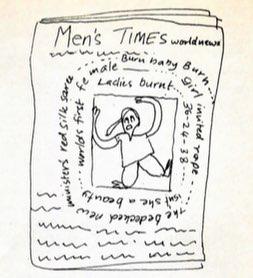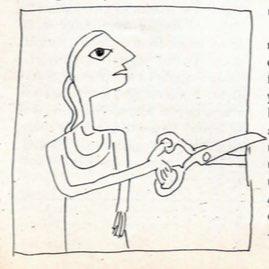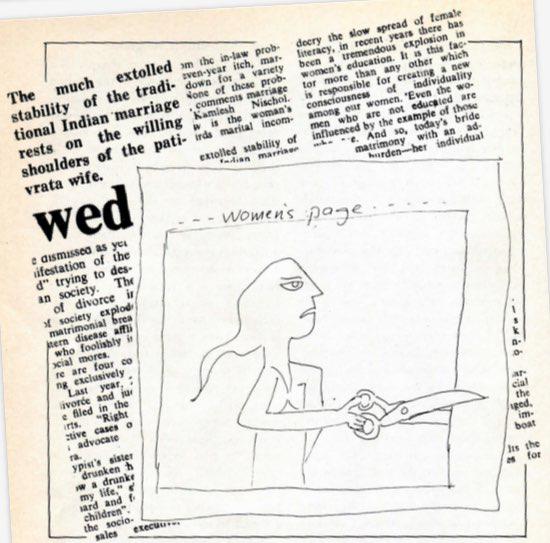Sujata Madhok
Adapted from an article that appeared originally in 'The Sexist Media', Seminar (New Delhi) August 1984.

The cartoon shows a mother-in-law pouring a can of kerosene on a hapless bride. 'It isn't kerosene, my dear, it's your flight of fancy', Ma-in-law says, while hubby follows with the matches.
Murder, one always thought was not a subject for humour. But this educative cartoon illustrates a serious article in a news tabloid on the Delhi High Court judgement in the Sudha Goel burning case (Blitz, December 3, 1983. This little cartoon which Blitz considered worth reproducing is by no less an artist than Abu Abraham.) The serious intent of the article is further vitiated by frivolous sub-headings. For instance, a paragraph which concludes that more women will continue to get burnt until they find the economic and emotional independence to walk out of destructive marriages, is given the outrageous sub-head 'Burn, baby, burn till independence comes'.
Appalling as these examples are, they come from the same mainstream media which has carried hundreds of sensitive reports on the torture and burning of brides. These products of the sexist way of thought represent a reaction to the emergence of a more egalitarian approach towards women. Humour is one weapon which has always been used to attack women and trivialise their problems and concerns; it is not surprising that it is through the humour columns that the chauvinists are hitting back — it is subtle and more difficult to counter than dogmatic, misogynist statements.
Wife-battering is an issue that women's organisations have not yet taken a public, political stand on, nor has it been the focus of any media debate. Yet, as any social worker, activist, lawyer or doctor will tell you, it is a problem of gigantic proportions. Male humourists, however, would have you believe quite the opposite. So the husbands of Kanpur (as India Today, March 15, 1984, again reports in its humour column) have been forced, poor chaps, to organise a forum for defence against their wives. 'One bright morning hundreds of aggressive wives woke up and reached for their rolling pins to find themselves stopped in their tracks by a poster which their husbands were holding up in the fashion of a shield. 'Pati Manch' it said simply — Husbands' Forum. The henpecked husbands of (the city of) Kanpur had taken time off from dressing their wounds to gather into a kind of North Indian Treaty Organisation which protects husbands... 'One way of denying the reality of oppression is to stand it on its head and posit the reverse as the truth. So, husbands become hapless victims in cartoon after cartoon, one humour column after another.

The media has other uses for the second major campaign carried out by women's organisations — the campaign against rape. Perhaps the most flagrant in its reporting has been the small Delhi-based monthly newsmagazine, India 2000, which carried on its cover, in full colour, the fleshy figure of a plump, almost nude Indian woman lying on a white sheet, with the word 'rape' emblazoned over her body (December 1983). The woman is covering her face with her hands but neither the gesture nor the posture reveal the agony of rape. The body, far from being contorted in pain, simply lies there for display. The accompanying article is objectionable in its very tone. It says casually, 'The Mathura case was, as rapes go, somewhat pedestrian' and goes on to describe it as 'an ambiguous investigation of an alleged assault by two pyjama-clad policemen, of a somewhat precocious and sexually forward girl.' Note how the fact of the policemen wearing pyjamas is casually brought in to trivialise the rape, and Mathura's alleged 'sexual forwardness' is put forth as an excuse for laying her open to such assault.
Stills of violent rape scenes from films illustrate many magazine articles on 'bold' cinema. In such cases while the articles piously pretend to decry exploitation of the female body on the screen, the accompanying visuals only perpetuate that exploitation, sending sales figures zooming.
Until a few years ago, use of the word rape was banned in many publications, as being too indelicate for respectable society. Thanks to the agitation on the Mathura case and the many agitations that followed, reporting of rape has gone up — but so has misreporting of these sexual crimes. Nevertheless, the mainstream news media, particularly newspapers, have played a most significant role in exposing rape. The Criminal Law Amendment Bill, 1980 has also been widely debated in the media, although few journalists have studied the censorship implications of the clause forbidding reporting of any circumstances which indicate the identity of the raped woman.

What are the other slots in which women are put, since the issues are few and far between as far as the news media are concerned?
Women certainly do not make headline news, as a glance at the dailies will show. In fact they do not make front page news at all, either as a group or as individuals, with the exception of one or two politicians. Mrs. Gandhi's pronouncements on almost any issue were usually up front. Yet, when she addressed a women's rally on International Women's Day she got local page treatment. The Statesman (March 9, 1983) reported at length, and with accuracy, her speech stressing the need to increase women's awareness of their rights and to accord them better status. In the last para, however, the reporter could not suppress his sarcasm. 'The function began two hours behind schedule and a classical dance and the recital of Iqbal's Sare Jahan Se Accha1 gave the function an air of a children's rally.'
Apart from Mrs. Gandhi (who everyone would have us believe was female only by an accident of birth), there are few women politicians with either the youth or glamour that draw newsmen like flies to a honeypot. So it is the film actress-turned-politician like Jayalalitha (Sunday, June 27-July 3, 1982) or the beautiful and controversial Shalinitai Patil (The New Hit Woman, Sunday January 15-21, 1984) who make the cover pages of our leading news magazines. Double column photographs adorned the local page of at least two Delhi dailies, which reported in detail the proceedings of the press conference Jayalalitha held to mark her Parliamentary debut. There is in both reports a certain admiration for this 36-year-old star, but one is rather patronising: 'Miss Jayalalitha, propaganda secretary of the AIADMK2 and the party's deputy leader in the Rajya Sabha† on Thursday served notice that she intended to take her new role in the house very seriously.' The report goes on, 'Displaying a great deal of self-assurance right from the beginning... Miss Jayalalitha answered all questions without faltering and with verve.'
The reporter is surprised that Jayalalitha can answer questions without faltering — he obviously expected a political innocent. He is also incredulous at the fact that a woman, and an actress at that, should be serious! It comes as no surprise then that all her pronouncements on the Sri Lanka Tamils issue, her attack on the DMK,3 and her defence of her party's stand should have been relegated to second place. It is through such subtleties of bias that subconscious sexism often reveals itself.
Meanwhile, that elsewhere in this country thousands of destitute widows starve on the streets of holy cities like Varanasi and Mathura, begging or selling their bodies for a handful of rice, is not a story that has made the cover pages of any publication.
Since politics is the staple of our newspapers, it follows then that women are pushed to the background in the dailies. It is the culture pages that help to round out the portrayal through reviews of exhibitions by women artists, performances by female musicians, critiques of plays produced or acted in by women, but here too it is the seductive Swapnasundaris and Sonal Mansinghs or the sexy Silk Smithas and razzle-dazzle Rekhas who the camera and the pen focus on. Wholly absent from the film reviews is any critique of the stereo-typing of women into good and bad. One may not expect feminist critiques but is it too much to ask for open minded, liberal reviewers who can perceive the blatant anti-woman bias in our films?
Only the sports pages carry some positive news of the achievements of women athletes and players. Yet, even here, when women achieve positive or even spectacular results, men find ways of undermining or ridiculing their success. During the last tennis season, when Wimbledon fever was at its height, one remembers having read a syndicated feature (reproduced in an Indian paper from a British tabloid) which devoted several columns and some photographs to top female tennis players. It was not Billy Jean King's ATP ranking or past Wimbledon scores that the feature focused on but the shape and colour of her underwear! Panties, not players, were analysed in this outrageous piece.
Indian papers may not yet be as adept at up-ending priorities, but they are fast getting there. Take two little cartoons that appeared recently. One was about the first women's cricket Test played between India and Australia. For female cricketers this was an outstanding event, but the cartoon showed a woman in sports gear on the field, with the crowds in the stands behind. No, she wasn't hitting a sixer, she was simply standing there concentrating on her knitting. The other cartoon spoofs Indian women's pioneering attempt to climb Mt. Everest; it shows two women scaling the peak, to be greeted by a beaming chaatwala. 'I knew there were women in the expedition,' runs the caption. The message? Women may conquer the highest mountain in the world but men have got there already and can afford to treat them as the frivolous females they are, feeding them junk food like chaat.4
In all fairness, however, one must point out that in the past five or six years, in response to women's campaigns for justice and equality, there have been positive changes. One does see the occasional editorial and edit page article on women's issues. The Statesman has introduced two fortnightly columns 'Women and Law' and 'Woman About Town'. The Indian Express has carried a series on women and law by P.N. Bakshi, the Hindustan Times has a column on 'Women We Hardly Know' in its magazine section. The Patriot for quite some time carried an interesting women's page but later whittled it down to half and has now done away with it altogether.
Reporting has gone up sharply. For instance, press response to the Mahila Dakshata Samiti's (a women's organisation) para-legal course in Delhi was very good. During the two-month course, almost all the lectures (held thrice a week) given by top jurists, lawyers, social workers and police officers, were reported by the local papers. Today you are as likely to see a newspaper photograph of a women's demonstration as one of a beauty contest or a women entrepreneurs' conference. In fact, there is a general feeling that women's organisations are given favoured treatment by the press. There is more than a grain of truth in this. Even a small demonstration by thirty or fifty women on dowry or rape is more likely to be covered by the press than one by several hundred male workers for an increase in pay or bonus. It is a conscious policy of the capitalist press to play down or completely ignore labour issues, but women's issues are a novelty so far and are not perceived either as a political threat or a threat to the class structure.
Where working class women struggle around class oppression, however, media response is not so forthcoming. One instance is the rape of workers' wives by goondas and policemen to break a strike in Hansi. Women and children were attacked in their homes while the men were away at a gate meeting outside the factory. The incident was head-lined by Patriot but all the other national dailies ignored it. More recently, the agitation of female telephone operators for regularisation of their jobs and the strike by govern ment school teachers (the majority are women) received sparse coverage in the Capital's dailies. Similarly one can recall only four or five reports of sexual harassment of women workers having appeared in the Delhi press in as many years, even though such harassment is widespread.

When India Today (February 2, 1982) did a ten-page cover story on Datta Samant, 'The Striking Terror', who led the textile strike in Bombay, there was not a word nor a line in it about the women workers who took part in the heroic struggle, not a word nor a line about the wives of the male workers who fought alongside their men through the prolonged strike. The only woman mentioned was Samant's wife. India Today says that his lifestyle allows 'the maverick labour leader little time to spend with his wife, Vanita, and his five children.' The impression is of Samant's wife as a housewife. But Sunday, speaking of the paradoxical connection between Samant and the Congress(I) says, 'His wife Mrs. Sunita Samant, is a Congress(I) municipal councillor. Mrs. Samant is often seen on the platforms of her husband's meetings.' India Today seems to have assumed that she is a housewife, and has even got her name wrong!
And what of all those invisible textile workers. Women's organisations have been greatly concerned at the mass retrenchment of female workers in Bombay's textile mills. In the past 35 years their number fell from 35,000 to a mere 5,000 on the eve of the strike. Now that the strike is over, 2,500 women workers have been victimised and refused reinstatement not only by mill-owners but also by the National Textile Corporation which has 'nationalised' several mills.
For such information one cannot, however, turn to mainstream news media. Instead it is in the alternative press, in small bulletins put out by research units or trade unions or women's organisations (in this case the National Federation of Indian Women bulletin, March 1984) that one finds such news.
Missing from mainstream media is the ordinary woman, the wage labourer in the fields, the bonded labourer in kilns and mines, the worker in the factory, the piece-rated home worker whose labour hundreds of industries depend on, the housewife and childrearer whose industry, whose production and reproduction, keep the economy going.
Missing also from editorial pages is all comment on inequalities in the wage structure, the adverse effects of selectively pro-male development policies, the discrimination effected by mechanisation, the relative malnutrition of women, and the inadequate medical facilities which force lakhs to go to quacks for abortions, the lack of trained personnel to attend the overwhelming majority of births and the consequently high maternal mortality rates.
Missing again is any real concern with children's issues, with, for instance, the education of the very young, because children are lumped with women and both relegated to second place in the patriarchal structure.
Missing from even investigative reports on exploitation in the countryside is news about women's status, because male reporters cannot physically approach rural women in highly conservative societies. So it is only male voices you hear in these reports, even when they speak of oppression and ceaseless toil.
The sex-class bias simply invisibilises women. As we unite to struggle against sex and class oppression, we must struggle too for equal space in the media.
_____________________________
1. A patriotic song.
2. The regional party in power in Tamil Nadu, South India.
The Upper House of the Indian Parliament.
3. The opposition party in Tamil Nadu.
4. A spicy Indian savoury

